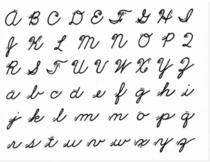Elrel Fri 05-Jun-20 09:24:41Does anyone remember the perfect copperplate which was used on railway station chalkboards? Beautiful, legible, written with care and pride to tell us of train delays and cancellations!
Elrel In the first term of my Grammar School back in 1957 we were taught italic script using a broad italic nib. (We had special nibs for the left handed.) The style wasn't enforced and there was no other tuition in handwriting style after that first term.
Some of us just took to it, me included. It became an art form for me. I learned that if you use a lined template of equidistant horizontal, vertical and diagonal lines, underneath the page that you are writing on, you can achieve a uniform dimension to each letter.
Taking that one stage further, if it's something like a wedding album or a curriculum vitae, I would write out the letter in pencil, then measure and adjust each letter to a standard not unlike the printed word. This not only ensures uniformity it also works like a spellchecker, if you make a spelling mistake or accidentally omit a word, it can be very frustrating.
Following that I would write over the pencil in ink using the broad italic nib. When that was finished and completely dry I can now use that as a perfect template. Just place it under the page that is to be written on and write following the template. Perfect copperplate. I can do it freehand too, but not quite as good as the above method.
It is time consuming of course but it's a hobby of mine. Over the years I learned a few styles, Old English Gothic is one that making a mistake on can turn the air blue.
Copperplate handwriting has always made an impression, or at least got a response, but by and large I just write freehand with a fountain pen and italic nib using a horizontal lined template underneath.


